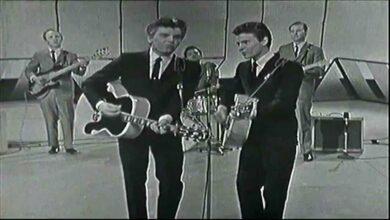Just as Buddy Rich was the drumming maestro, Earl Scruggs was the supreme banjo player.
Lester Flatt and Earl Scruggs’s performance of “The Ballad of Jed Clampett” stands as a monumental moment in the history of bluegrass and country music, marking a significant crossover into mainstream television and popular culture. This song, famously known as the theme for the television show “The Beverly Hillbillies,” epitomized the blend of storytelling, humor, and masterful musicianship that defined the bluegrass genre. Lester Flatt’s smooth vocals and rhythm guitar combined with Earl Scruggs’s innovative banjo playing created a sound that was both traditional and fresh, appealing to a wide audience beyond the bluegrass purists.
“The Ballad of Jed Clampett” tells the story of a poor mountaineer who becomes wealthy after discovering oil on his property, leading his family from their rural home to the upscale environs of Beverly Hills, California. The song’s lyrics, coupled with Flatt and Scruggs’s engaging performance, captured the imagination of viewers and listeners, contributing significantly to the show’s success and the song’s enduring popularity. The blend of humor, narrative, and musicianship made the song a perfect fit for the television series, which itself was a blend of comedy and social commentary.
Lester Flatt, born in 1914, was a skilled guitarist and vocalist known for his clear, concise singing style and his ability to convey the emotional depth of a song. His contributions to the bluegrass genre were immense, not only in his performances but also in his songwriting. Flatt’s partnership with Earl Scruggs, which began in 1948, marked a defining era in bluegrass music, with the duo pioneering a sound that would influence countless musicians in the years to come.
Earl Scruggs, born in 1924, revolutionized banjo playing with his three-finger picking style, which came to be known as “Scruggs style” banjo. This technique allowed for a more rapid, rolling melody line that gave bluegrass music its distinctive sound. Scruggs’s innovation on the banjo elevated the instrument from a background rhythm component to a lead instrument, showcasing its potential for complexity and expressiveness.
The collaboration between Lester Flatt and Earl Scruggs was one of the most fruitful in the history of American music. Their band, Flatt & Scruggs and the Foggy Mountain Boys, became a seminal force in the bluegrass genre, pushing the boundaries and setting new standards for musicianship and performance. Their extensive touring and recording work, including “The Ballad of Jed Clampett,” left an indelible mark on the music world, influencing generations of musicians and fans.
“The Ballad of Jed Clampett” was not just a song but a cultural phenomenon that brought bluegrass music to a national television audience weekly. Its success on the Billboard charts, where it reached number one on the country charts and crossed over to the pop charts, underscored the song’s wide appeal. This exposure was instrumental in bringing the sound of bluegrass to new audiences and cementing Flatt and Scruggs’s status as musical icons.
Beyond their musical partnership, both Flatt and Scruggs made significant contributions to music after they parted ways in 1969. Lester Flatt continued to perform and record, forming a new band, “Nashville Grass,” which helped to launch the careers of future bluegrass stars. Earl Scruggs, on the other hand, explored various musical styles, collaborating with artists across different genres and demonstrating the versatility of the banjo in various musical contexts.
In conclusion, Lester Flatt and Earl Scruggs’s performance of “The Ballad of Jed Clampett” is a landmark in the annals of American music. It represents not only the pinnacle of bluegrass artistry but also a moment when a genre traditionally relegated to the margins of American music was thrust into the mainstream. The song, and the artists behind it, embody the spirit of innovation, tradition, and crossover appeal that has come to define much of American music history. Their legacy continues to inspire and influence musicians and fans alike, ensuring that their contributions to music will be remembered and celebrated for generations to come.
?si=G7YSDVplQsXR6flM





